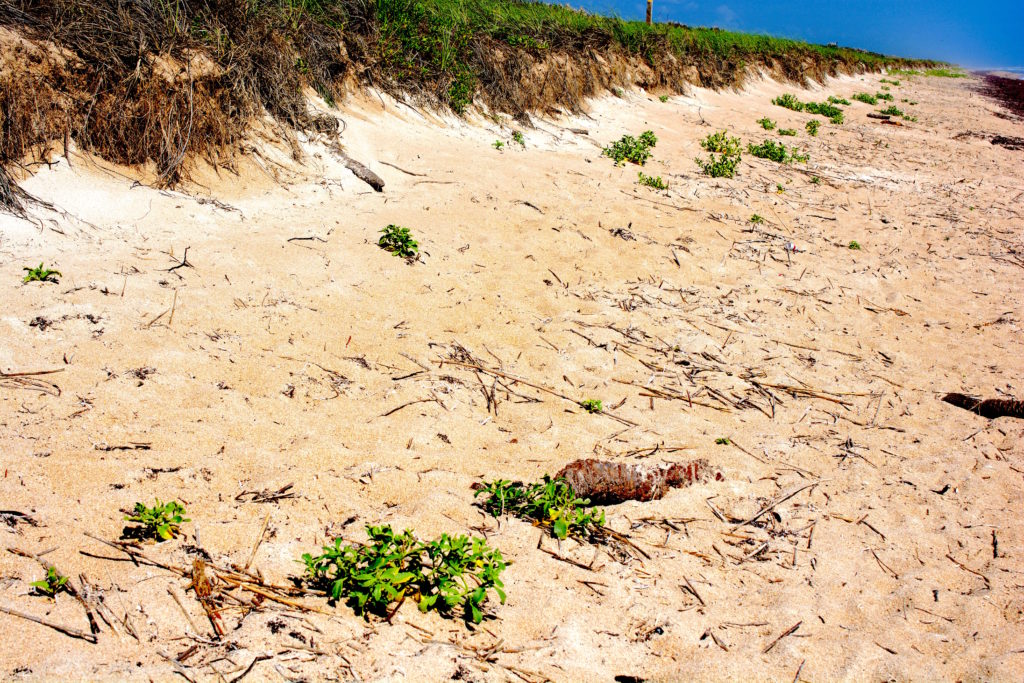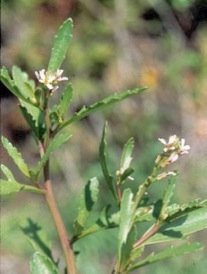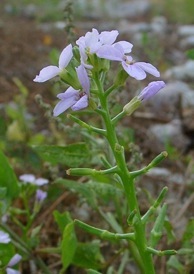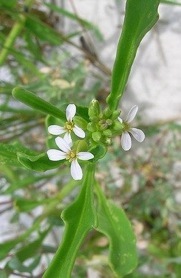
Wild mustards are easy to spot on our beaches. They are between the wrack line and the lift of the dune. (The root is unrelated debris.) Photo by Green Deane
The Cakile Clan: Seaside Edibles
Food is where the water is, be it fresh or salt, and one of the waterway foods of North America is Sea Rocket. There are at least five native Sea Rockets and one or two imports.
Cakile species are perennial that can grow upright or spread out. They grow close to the coast, often in dunes. Leaves are fleshy, the flowers are typically pale mauve to white, with four petals about a third of an inch in length. They are rather similar to those of the wild radish, that is, the petals have veins whereas mustards petals do not. Identifying leaves and stems is the way to tell them apart. The leaves are also peppery and have a nose of mustard.
The most common is Cakile edentula (kah-KIL-ee e-DEN-tuh-luh.) It can be found from California to Alaska, Louisiana to Greenland and land boarding the Great Lakes. Florida has its own version, Cakile Lanceolate (lan-see-oh-LAY-tuh) that runs from Texas to Florida and Puerto Rico. C. maritima, from Europe, is found on the west coast, California to British Columbia, coastal Texas and Alabama, North Carolina to Long Island. It is said muh-RIT-tim-muh, Latin, or mar-ih-TEE-muh, British. The point is, if you are near big water, there is a Sea Rocket near you and their ranges overlap. The goal is to learn your local variety or varieties. Not all of the Sea Rockets are used the same though they are similar. So let’s look at these three individually.
Cakile edentula: Leaves and young stems, raw or cooked. The younger leaves are used in salads, the older leaves are mixed with milder greens and used as a potherb. The flavor is similar to horseradish. The root can be dried and ground into powder. That can be mixed with flour and used to make bread. Said bread is a famine food.
Cakile maritima: (European Sea Rocket) Leaves, stems, flower buds and immature seed pods raw. They can be cooked but cooking makes them very bitter. However, they are rich in Vitamin C. Their root can also be dried and used.
Cakile lanceolata: (Southern Sea Rocket) Leave and steams eaten raw or cooked, has a mustard flavor. Young shoots or tips are excellent. No report on the root and I haven’t tried it. Leaves can have an ether taste but I have not encountered it.
Medicinally, boiled leaves have been used to clean persistent wounds.
Cakile is an old Arabic name for the plant. Edentula means without teeth, maritima, of the sea, and lanceolata, lance shaped. Sea Rocket comes from the rocket-shaped seed pods.
Green Deane’s “Itemized” Plant Profile
IDENTIFICATION: C. edentula, low, fleshy, branching beach plant with pale lavender flowers, not heavily toothed or not at all, found on the above the high-tide line of beaches, seed pods angular, succulent young stems and leaves somewhat like horseradish. C. maritima has very deeply lobed leaves, shiny, fleshy, green, tinted with purple or magenta, long-lobed, white to light purple flowers, sculpted, segmented, corky brown fruits to an inch long. C. lanceolata has long leaves that can be toothed or not or irregular but not deeply lobed. Pods cylindrical. Flowers white to light purple.
TIME OF YEAR: Mid spring to the autumn depending on climate.
ENVIRONMENT: Found on the above the high-tide line of beaches, oceans, Great Lakes and local rivers.
METHOD OF PREPARATION: Leaves and stems of all raw, leaves and stems of the C. edentula and C. lanceolata can be cooked. C. Maritima becomes very bitter when cooked. The root pounded and dried and mixed with flour and baked for a famine food.




